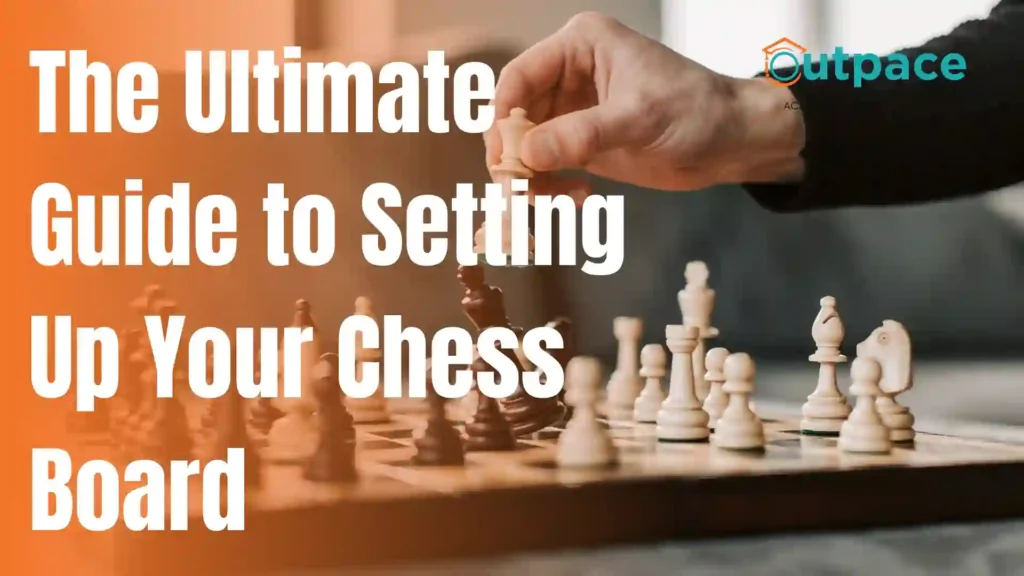
Are you ready to master the timeless game of chess? From setting up your chess board to learning essential strategies and rules, this ultimate guide is your key to becoming a formidable player. Whether you’re a beginner or an experienced player looking to elevate your game, we’ve got you covered.
In this comprehensive guide, we’ll walk you through the process of setting up your chess board, ensuring every piece is in its rightful place. We’ll also explore tips and strategies to help you improve your gameplay and outsmart your opponents. With a clear understanding of basic rules and winning tactics, you’ll be ready to take on any challenge that comes your way.
Whether you’re playing for fun or competing in tournaments, chess is a game that tests your critical thinking, strategic planning, and decision-making skills. By mastering the art of setting up your chess board and implementing effective strategies, you’ll be able to navigate the intricate moves and develop a winning mindset.
Get ready to dive into the world of chess and unlock your full potential on the board. Let’s begin this exciting journey together!
Understanding the Chessboard and Pieces : Guide to Setting Up Your Chess Board
Chess is played on an 8×8 grid known as the chessboard, which consists of 64 alternating dark and light squares. Each square is identified by a unique coordinate system, using letters for columns (a-h) and numbers for rows (1-8). The board is set up so that each player has a light square on their right corner. Familiarizing yourself with the layout is crucial, as it forms the foundation of your gameplay. Understanding how the board is structured enhances your ability to visualize moves and strategize effectively.
The chess pieces consist of six different types: pawns, knights, bishops, rooks, queens, and kings. Each piece has its own unique movement pattern and value, which plays a significant role in your strategy. Pawns move forward one square but capture diagonally, while knights move in an L-shape, allowing them to jump over other pieces. Bishops glide diagonally across the board, rooks move vertically or horizontally, queens can move in any direction, and kings can shift one square in any direction. Recognizing these movements is essential for planning both offense and defense.
Understanding the relative strength of each piece is also vital. For instance, the queen is the most powerful piece on the board, while the pawn is the weakest. However, pawns have the potential to be promoted to any piece (except a king) once they reach the opposite end of the board. This unique aspect of pawns can create tactical opportunities, making it essential to value even the least powerful pieces appropriately. Mastering the roles and movements of each piece will significantly enhance your overall game strategy.
Setting Up the Chessboard Correctly : Guide to Setting Up Your Chess Board
Setting up the chessboard correctly is the first step in playing a game of chess. Begin by ensuring that the board is oriented properly; each player should have a light square on their right side. The pieces are then arranged in a specific order on the two rows closest to each player. The back row, or first row, is where the major pieces are placed, while the second row is reserved for pawns.
For the back row, start from the corners with the rooks, then place knights next to them. The bishops follow, positioned next to the knights. The queen is placed on her color—white queen on a light square, black queen on a dark square—and finally, the king goes on the remaining square. This arrangement ensures that each player’s pieces are set up correctly, allowing for a balanced start to the game. It’s essential to double-check your setup to avoid confusion during gameplay.
After the major pieces are set up, the second row is filled with eight pawns. Each player has eight pawns, and their primary purpose is to advance across the board, control space, and protect more valuable pieces. The proper setup of the chessboard not only prepares you for the game but also sets the tone for strategic play. With everything in place, you’re ready to begin your chess journey.
Basic Rules of Chess : Guide to Setting Up Your Chess Board
Chess has a set of fundamental rules that govern how the game is played. Each player takes turns moving one piece at a time, with the goal of checkmating the opponent’s king. Checkmate occurs when the king is under threat of capture and cannot escape from that threat. If a king is in check but can move to a safe square or another piece can block the attack, the game continues. Understanding these basic concepts is crucial for beginners.
Another important rule involves capturing pieces. When a piece lands on a square occupied by an opponent’s piece, the opponent’s piece is removed from the board. However, a player cannot make a move that places their own king in check. This rule emphasizes the importance of protecting your king while devising strategies to capture your opponent’s pieces. Additionally, players should familiarize themselves with special moves, such as castling, en passant, and pawn promotion, which add depth to the game.
Chess is played until one player achieves checkmate, or the game ends in a stalemate, where no legal moves are available, but the king is not in check. Other outcomes include draws, which can happen due to insufficient material to checkmate, threefold repetition, or the fifty-move rule, where no pawn movement or captures occur over fifty turns. Understanding these basic rules is essential for engaging in competitive play and enjoying the strategic depth of chess.
Strategies for the Opening Phase of the Game : Guide to Setting Up Your Chess Board
The opening phase of a chess game is critical for establishing a strong foundation. During this phase, players focus on piece development, control of the center, and king safety. A common strategy is to develop pieces from the back row to the center of the board, allowing for greater mobility. Strong openings often involve moving the pawns in front of the knights and bishops, facilitating their development while controlling key central squares.
Controlling the center of the board is paramount in chess. The four central squares (d4, d5, e4, e5) provide the greatest influence over the game, allowing pieces to move freely across the board. Players should aim to place their pawns and pieces in these central positions, as doing so maximizes their control and limits the opponent’s options. Opening with popular strategies, such as the King’s Pawn Opening or the Queen’s Gambit, can help establish control over the center early in the game.
King safety is another crucial aspect of the opening phase. A common tactic is to castle early, which not only secures the king but also connects the rooks. Castling can be performed on either side, with kingside castling being the more common choice. It’s important to remember that while developing pieces and controlling the center, players must remain vigilant about their opponent’s threats. Being proactive in the opening phase often sets the stage for a successful middle game.
Tactics for the Middle Game : Guide to Setting Up Your Chess Board
As the game transitions from the opening to the middle phase, the focus shifts towards executing tactics and creating advantageous positions. The middle game is where players can employ various strategies such as attacking the opponent’s king, targeting weak pawns, or exploiting poorly positioned pieces. Understanding how to recognize tactical opportunities is essential for gaining an edge over your opponent.
One of the most common tactics in the middle game is the concept of pins and forks. A pin occurs when a piece cannot move without exposing a more valuable piece behind it, while a fork involves one piece attacking two or more of the opponent’s pieces simultaneously. Knights are particularly effective at creating forks due to their unique movement style. Recognizing these tactics can lead to significant material gains and advantageous positions on the board.
Another important aspect of the middle game is the creation of weaknesses in your opponent’s position. Look for opportunities to double your rooks on an open file, isolate pawns, and create imbalances that can be exploited. It’s also crucial to maintain flexibility in your strategy, allowing for adjustments based on your opponent’s moves. The middle game requires a combination of creativity and calculation, making it a critical phase for any chess player aiming for victory.
Endgame Strategies and Techniques : Guide to Setting Up Your Chess Board
The endgame phase is where the real test of a player’s skill and knowledge comes into play. With fewer pieces on the board, players must utilize their remaining resources wisely to either achieve checkmate or force a draw. A strong understanding of endgame principles can be the difference between winning and losing. Key objectives during this phase include promoting pawns, controlling key squares, and ensuring the safety of your king.
Pawn promotion is perhaps the most significant goal in the endgame. A pawn that reaches the opponent’s back rank can be promoted to any piece, typically a queen. This promotion can drastically shift the balance of power on the board, making it vital to advance pawns carefully while protecting them from capture. Additionally, players should aim to create passed pawns—pawns that have no opposing pawns blocking their path to promotion—since they pose a significant threat to the opponent.
King activity is also crucial in the endgame. Unlike in the opening and middle game, where the king is often kept safe, in the endgame, it becomes a powerful piece that can influence the outcome. Players should actively use their king to control key squares and support their remaining pieces. By combining pawn promotion strategies with effective king maneuvers, players can secure victory in the endgame.
Tips for Improving Your Chess Skills : Guide to Setting Up Your Chess Board
Improving your chess skills requires a combination of practice, study, and reflection. One of the most effective ways to enhance your gameplay is to study classic games played by grandmasters. Analyzing their strategies, openings, and endgame techniques can provide valuable insights into effective play. Books, online resources, and instructional videos can serve as excellent tools for learning and understanding the intricacies of the game.
Another important aspect of improvement is consistent practice. Engage in regular games with players of various skill levels, as this exposes you to different strategies and playing styles. Online platforms are a great way to find opponents and practice in a low-pressure environment. Additionally, consider solving chess puzzles, which help sharpen your tactical vision and pattern recognition skills.
After playing games, it’s crucial to review your moves and decisions. Analyze the positions you encountered, and reflect on any mistakes made. Tools like chess engines can assist in evaluating your gameplay and identifying areas for improvement. Keeping a chess journal to document your games, thoughts, and lessons learned can also be a helpful method for tracking your progress. With dedication and effort, you can steadily enhance your chess skills and become a more formidable player.
Common Mistakes to Avoid in Chess : Guide to Setting Up Your Chess Board
As you embark on your chess journey, it’s important to be aware of common mistakes that many players make. One prevalent error is neglecting piece development in the opening phase. Failing to develop pieces means that you won’t control the center effectively, leading to a disadvantage early in the game. Always aim to mobilize your pieces and create a strong position before launching attacks.
Another mistake is overextending or isolating pawns. While advancing pawns is crucial for control and promotion, overextending them can create weaknesses that your opponent can exploit. Isolated pawns, which have no adjacent pawns for support, can become easy targets. Striking a balance between aggression and defense is essential to avoid falling into traps set by your opponent.
Lastly, many players overlook the importance of king safety throughout the game. While the king is often kept safe during the opening and middle game, it must also be considered in the endgame. Failing to protect your king can lead to unexpected checkmates or forced losses. Always be vigilant about your king’s safety and position it strategically to ensure that it remains a valuable asset throughout the entire game.
Conclusion and Next Steps : Guide to Setting Up Your Chess Board
In conclusion, mastering the art of chess requires a deep understanding of the board, its pieces, and the strategies that govern gameplay. By correctly setting up your chessboard, learning the basic rules, and employing opening, middle, and endgame tactics, you can significantly enhance your playing skills. Additionally, continuous practice, study, and reflection on your games will pave the way for improvement.
As you continue your chess journey, consider joining local clubs or online communities where you can engage with other players, participate in tournaments, and gain valuable experience. The chess world is vast and offers countless opportunities for growth. Embrace the challenges, learn from your mistakes, and celebrate your victories.
With dedication and perseverance, you can unlock your full potential on the chessboard and become a formidable opponent. Remember, every master was once a beginner, and with each game, you have the chance to learn something new. Happy playing, and may your chess journey be filled with excitement and success!



